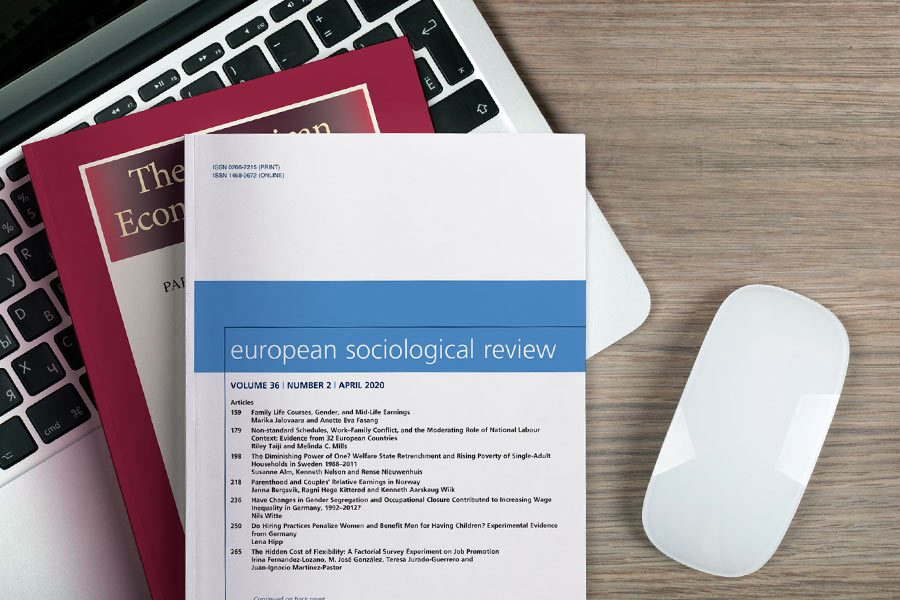Total hits 17.213
-
The SOEP user support and information system
Anger, S., Bowen, D., Engelmann, M., Frick, J., Goebel, J., Grabka, M., Groh-Samberg, O., Haas, H., Holst, E., Krause, P., Kroh, M., Kurka, C., Lohmann, H., Pischner, R., Rahmann, U., Schmitt, C., Schräpler, J., Schupp, J., Sieber, I., Siedler, T., Spieß, C., Spieß, M., Tucci, I. & Wagner, G. (2008): The SOEP user support and information system. In: B. Headey & E. Holst (Hrsg.) (2008): A quarter century of change : results from the German Socio-Economic Panel (SOEP) (SOEP Wave report, 1-2008), p. 114-119.
-
Bunt in die Zukunft
Steinhardt, M., Stiller, S. & Damelang, A. (2008): Bunt in die Zukunft. Kulturelle Vielfalt als Standortfaktor deutscher Metropolen. Hamburg, 16 p.
-
Women and men in the labour market: Who's ahead?
König, M. (2008): Frauen und Männer auf dem Arbeitsmarkt: Wer macht das Rennen? In: IAB-Forum No. 2, p. 22-27.
-
BA Employment Panel 1998-2006, Codebook
Schmucker, A. & Seth, S. (2008): BA-Beschäftigtenpanel 1998-2006. Codebuch. (FDZ-Datenreport 01/2008 (de)), Nürnberg, 116 p.
-
25 Wellen Sozio-oekonomisches Panel
Anger, S., Bowen, D., Engelmann, M., Frick, J., Goebel, J., Grabka, M., Groh-Samberg, O., Haas, H., Headey, B., Holst, E., Krause, P., Kroh, M., Kurka, C., Lohmann, H., Pischner, R., Rahmann, U., Schmitt, C., Schräpler, J., Schupp, J., Sieber, I., Siedler, T., Spieß, C., Spieß, M., Tucci, I. & Wagner, G. (2008): 25 Wellen Sozio-oekonomisches Panel. In: Vierteljahrshefte zur Wirtschaftsforschung, Vol. 77, No. 3, p. 9-14.
-
Soziale Herkunft und Bildungsziele von Jugendlichen im Armutsbereich
Krug, G. & Popp, S. (2008): Soziale Herkunft und Bildungsziele von Jugendlichen im Armutsbereich. (IAB-Discussion Paper 42/2008), Nürnberg, 31 p.
-
Returns to education: not until 2005 did East German men do as well as Westerners, but Eastern women did better
Lupo, K. & Anger, S. (2008): Returns to education: not until 2005 did East German men do as well as Westerners, but Eastern women did better. In: B. Headey & E. Holst (Hrsg.) (2008): A quarter century of change : results from the German Socio-Economic Panel (SOEP) (SOEP Wave report, 1-2008), p. 63-68.
-
The returns to cognitive abilities and personality traits in Germany
Heineck, G. & Anger, S. (2008): The returns to cognitive abilities and personality traits in Germany. (DIW-Diskussionspapiere 836), Berlin, 49 p.
-
Jüngste Arbeitsmarktreformen: Schöne Aussichten für ältere Arbeitnehmer?
Dietz, M., Klinger, S., Stephan, G., Walwei, U., Wolff, J. & Wübbeke, C. (2008): Jüngste Arbeitsmarktreformen: Schöne Aussichten für ältere Arbeitnehmer? In: IAB-Forum No. 1, p. 70-75.
-
KJC, gAW oder ZAG? - der politische Diskurs um die Neuorganisation der Betreuung der Empfänger von Hartz-IV-Leistungen
Steinke, J. (2008): KJC, gAW oder ZAG? - der politische Diskurs um die Neuorganisation der Betreuung der Empfänger von Hartz-IV-Leistungen. In: Gesellschaft, Wirtschaft, Politik, Vol. 57, No. 4, p. 463-470.
-
A note on the determinants and consequences of outsourcing using German data
Addison, J., Bellmann, L., Pahnke, A. & Teixeira, P. (2008): A note on the determinants and consequences of outsourcing using German data. (IZA discussion paper 3608), Bonn, 22 p.
-
Joblessness as a major challenge for public employment services
Arnkil, R., Di Domenico, G. & Konle-Seidl, R. (2008): Joblessness as a major challenge for public employment services. Country reports from Germany, Italy and Finland. In: R. Blanpain (Hrsg.) (2008): The global labour market : from globaliszation to flexicurity (Bulletin of comparative labour relations, 65), p. 81-107.
-
Multiple imputation of right-censored wages in the German IAB employment register considering heteroscedasticity
Büttner, T. & Rässler, S. (2008): Multiple imputation of right-censored wages in the German IAB employment register considering heteroscedasticity. In: Federal Committee on Statistical Methodology United States (Hrsg.) (2008): Federal Committee on Statistical Methodology Research Conference 2007, p. 1-21.
-
Ergebnisse der Bürgerbefragung 2008 in Fürth
Pabst, M., Sandig, C. & Weimann-Sandig, N. (2008): Ergebnisse der Bürgerbefragung 2008 in Fürth. Erlangen.
-
Arbeitslosigkeit als zentrale Dimension sozialer Ungleichheit - Essay
Blien, U. (2008): Arbeitslosigkeit als zentrale Dimension sozialer Ungleichheit - Essay. In: Aus Politik und Zeitgeschichte No. 40/41, p. 3-6.
-
Structure and extent of intergenerational income mobility in Germany
Schnitzlein, D. (2008): Verbunden über Generationen: Struktur und Ausmaß der intergenerationalen Einkommensmobilität in Deutschland. (SOEPpapers on multidisciplinary panel data research at DIW Berlin 80), Berlin, 24 p.
-
Wage subsidies for needy job-seekers and their effect on individual labour market outcomes after the German reforms
Bernhard, S., Gartner, H. & Stephan, G. (2008): Wage subsidies for needy job-seekers and their effect on individual labour market outcomes after the German reforms. (IZA discussion paper 3772), Bonn, 27 p.
-
The operational use of evaluation results in the restructured German public employment services
Konle-Seidl, R. & Schewe, T. (2008): The operational use of evaluation results in the restructured German public employment services. In: G. Di Domenico & S. Spattini (Hrsg.) (2008): New European approaches to long-term unemployment : what role for public employment services and what market for private stakeholders? (Studies in employment and social policy, 35), p. 127-136.
-
Rights and duties from beneficiaries' viewpoint : understanding and handling of social policy and labour market policy measures included in Social Security Code II
Wenzel, U. (2008): Fördern und Fordern aus Sicht der Betroffenen. Verstehen und Aneignung sozial- und arbeitsmarktpolitischer Maßnahmen des SGB II. In: Zeitschrift für Sozialreform, Vol. 54, No. 1, p. 57-78. DOI:10.1515/zsr-2008-0105
-
Trainingsmaßnahmen: Für welche unter 25-jährigen Arbeitslosengeld-II-Empfänger erhöhen sie die Beschäftigungschancen?
Hartig, M., Jozwiak, E. & Wolff, J. (2008): Trainingsmaßnahmen: Für welche unter 25-jährigen Arbeitslosengeld-II-Empfänger erhöhen sie die Beschäftigungschancen? (IAB-Forschungsbericht 06/2008), Nürnberg, 74 p.



